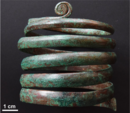Tiszapolgár culture
In this article, we will explore the topic of Tiszapolgár culture from different perspectives and with a multidisciplinary approach. We will analyze its impact on society, its relevance today and its evolution over time. In addition, we will examine the different opinions and theories that exist around Tiszapolgár culture, as well as its influence in different areas, such as culture, politics, economics and technology. Through this comprehensive analysis, we hope to provide a comprehensive and detailed view on Tiszapolgár culture, with the aim of enriching knowledge and encouraging debate around this topic.
 | |
| Horizon | Old Europe |
|---|---|
| Period | Eneolithic, Chalcolithic |
| Dates | 4500-4000 BC |
| Preceded by | Tisza culture, Vinča culture |
| Followed by | Bodrogkeresztúr culture |
The Tiszapolgár culture (4500–4000 BC) was an Eneolithic archaeological culture in Central Europe in the Carpathian Basin, in the Great Hungarian Plain. It located in the territory of present-day Eastern Hungary, in Eastern Slovakia, in Transcarpathia in Ukraine, and in Western Romania.
The type site Tiszapolgár-Basatanya is a town in northeastern Hungary (Polgár). It is a continuation of the earlier Neolithic Tisza culture. The type site Româneşti is located in the Româneşti-Tomeşti, Timiș County, Romania.
Most of the information about the Tiszapolgár culture comes from cemeteries; over 150 individual graves have been being excavated at Tiszapolgár-Basatanya. The pottery is unpainted but often polished and frequently decorated.
In 2022 a trove of 169 gold rings was found in Romania, in the burial of a high-status woman belonging to the Tiszapolgár culture. The trove was described as "a sensational find for the period".
Genetics
Lipson et al. (2017) found in the remains of five individuals ascribed to the Tiszapolgár culture three G2a2b and a subclade of it, and two I2a and a subclade of it. Of the five samples of mtDNA extracted, three belonged to T21c, one belonged to H26, and one belonged to H1.
Gallery
-
Tiszapolgar ceramics
-
Tiszapolgar ceramic vessel
-
Ceramic cups
-
Copper bracelet
-
Copper spiral ornaments
-
Copper beads
-
Copper spiral ornament
See also
Bibliography
- Lipson, Mark (November 16, 2017). "Parallel palaeogenomic transects reveal complex genetic history of early European farmers". Nature. 551 (7680). Nature Research: 368–372. Bibcode:2017Natur.551..368L. doi:10.1038/nature24476. PMC 5973800. PMID 29144465.
- Narasimhan, Vagheesh M. (September 6, 2019). "The formation of human populations in South and Central Asia". Science. 365 (6457). American Association for the Advancement of Science: eaat7487. bioRxiv 10.1101/292581. doi:10.1126/science.aat7487. PMC 6822619. PMID 31488661.
- Parkinson, William A. (1999): The Social Organization of Early Copper Age Tribes on the Great Hungarian Plain. University of Michigan
- Parkinson, William A.: Style and Social Interaction in the Early Copper Age of the Great Hungarian Plain. La Tinaja: A Newsletter of Archaeological Ceramics. 13(1):4-7. Ohio State University
- Sarris, Apostolos; Galaty, Michael L.; Yerkes, Richard W.; Parkinson, William A.; Gyucha, Attila; Billingsley, Doc M. & Tate, Robert: Investigation of Hungarian Early Copper Age Settlements through Magnetic Prospection & Soil Phosphate Techniques Archived 2012-02-17 at the Wayback Machine
- Sauer, Erin: Paleomeander Behavior in the Early Copper Age of the Great Hungarian Plain: Vészt″o,Hungary. The Ohio State University
- The Stone – Copper Age /The Eneolithic Age/Early Phase/5th Millennium BC, bilder av oldstidsgjenstander fra den aktuelle tidsepoke
References
- ^ "Trove of Gold Rings Is Uncovered in 'Sensational' Prehistoric Grave in Romania". Artnews. 15 August 2022.
- ^ Lipson 2017.
- ^ Narasimhan 2019.
External links
- Tiszapolgár
- The Tiszapolgár culture
- (in German)
- Trove of Gold Rings Is Uncovered in ‘Sensational’ Prehistoric Grave in Romania






